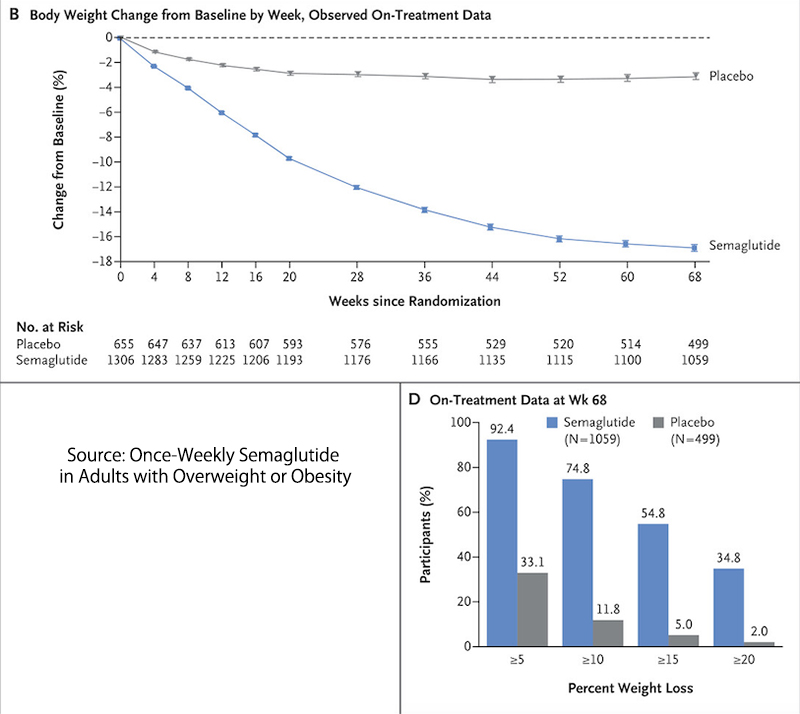
Mishegas
For those not in the tribe, mishegas is a Yiddish word for a craziness – those “foibles” or idiosyncratic worries that cause enough distress to be noticeable to others. My first was that I would not lose any weight. One week after that first injection, I eagerly lept onto the scale. I was rewarded with the loss of 8 ounces. That worry was lessened at the end of week two with a drop of 4 pounds. Amortized over the cost of therapy, those pounds  were far more costly than a Waygu steak.
were far more costly than a Waygu steak.
As it turns out, that worry is not unfounded. In a report in the New England Journal of Medicine touting the dramatic findings of semaglutide, most people are drawn to chart B and the dramatic reduction in weight after completing treatment. But that is the average for all the participants. A careful look at chart D shows that 25% of the participants did not experience a weight reduction of more than 10%. (Not that 10% isn’t an improvement; it just might not be the expectation.)
It is too early in the GLP-1 roll-out to the general public to fully understand why some individuals do better than others. Still, we should expect that outcomes will depend upon adherence to the treatment plan, changes in our behavior towards food, and genetics.
As this fear of no weight loss dissipated, it was replaced by a second “concern.” Weight loss using Ozempic is not limited to the fat producing my body’s contours but includes protein loss from muscle and, among other vital systems, our immune system. To counter that mishegas, I try to eat more proteins and eat them earlier in the meal before I begin to feel full and push the plate away. Parenthetically, some advocate eating proteins first because their digestion normally enhances the feeling of satiety.
A Study of One Association vs. Causality
In this observation study of one, I have noticed that my interest in eating and feeling fullness in my mid-abdomen seems to wax and wane. It seems to reach a peak about four to five days after the injection and reach a nadir in the 24-hour interval just before and after my weekly injection. Why might that be?
“Maximum concentration of semaglutide is reached 1 to 3 days post dose.”
That bit of pharmacokinetics comes from Ozempic’s package insert. The half-life of natural (endogenous) GLP-1  is 2 minutes. It is rapidly broken down by a proteolytic enzyme, dipeptidyl peptidase-4 (DPP-4), depicted to the right. Due to two changes in structure, semaglutide, the pharma version of GLP-1 has a half-life of one week. (I will leave a longer discussion of its altered chemistry to my colleague, Dr. Bloom). Most semaglutide is bound to albumin, a necessary protein our liver produces and widely present in our blood. As a result of individual albumin levels and the sensitivity to the effect of GLP-1, the efficacy of semaglutide’s peak concentration may vary from 3 to 5 days.
is 2 minutes. It is rapidly broken down by a proteolytic enzyme, dipeptidyl peptidase-4 (DPP-4), depicted to the right. Due to two changes in structure, semaglutide, the pharma version of GLP-1 has a half-life of one week. (I will leave a longer discussion of its altered chemistry to my colleague, Dr. Bloom). Most semaglutide is bound to albumin, a necessary protein our liver produces and widely present in our blood. As a result of individual albumin levels and the sensitivity to the effect of GLP-1, the efficacy of semaglutide’s peak concentration may vary from 3 to 5 days.
In my study of one, peak efficacy is associated with feelings of fullness and varying interest in eating. Hopefully, given that short preamble on enzyme degradation, half-lives, binding to albumin, and possible “genetic” sensitivity, you can see that association is not causation. Biological causes are almost always multi-factorial. Over the next few weeks, those Ozempic half-lives will build up, and by week five or six, I should reach a semaglutide steady state, which might shed more light on the underlying variation in my hunger and satiety.
The ups and downs on the scale and in my mind are a constant reminder that weight loss is a complex process influenced by numerous factors. Ultimately, patience and perseverance determine whether Ozempic becomes my magic bullet or a way-stop on my journey.
Sources: Not Everyone Loses Weight on Ozempic Wired
Once-Weekly Semaglutide in Adults with Overweight or Obesity NEJM DOI: 10.1056/NEJMoa2032183



